Understanding Business Organisations
VerifiedAdded on 2023/06/10
|8
|1987
|340
AI Summary
This essay discusses the different types of business organizations, organizational structures, business functions, and the positive impacts of organizational culture on achieving success in business.
Contribute Materials
Your contribution can guide someone’s learning journey. Share your
documents today.
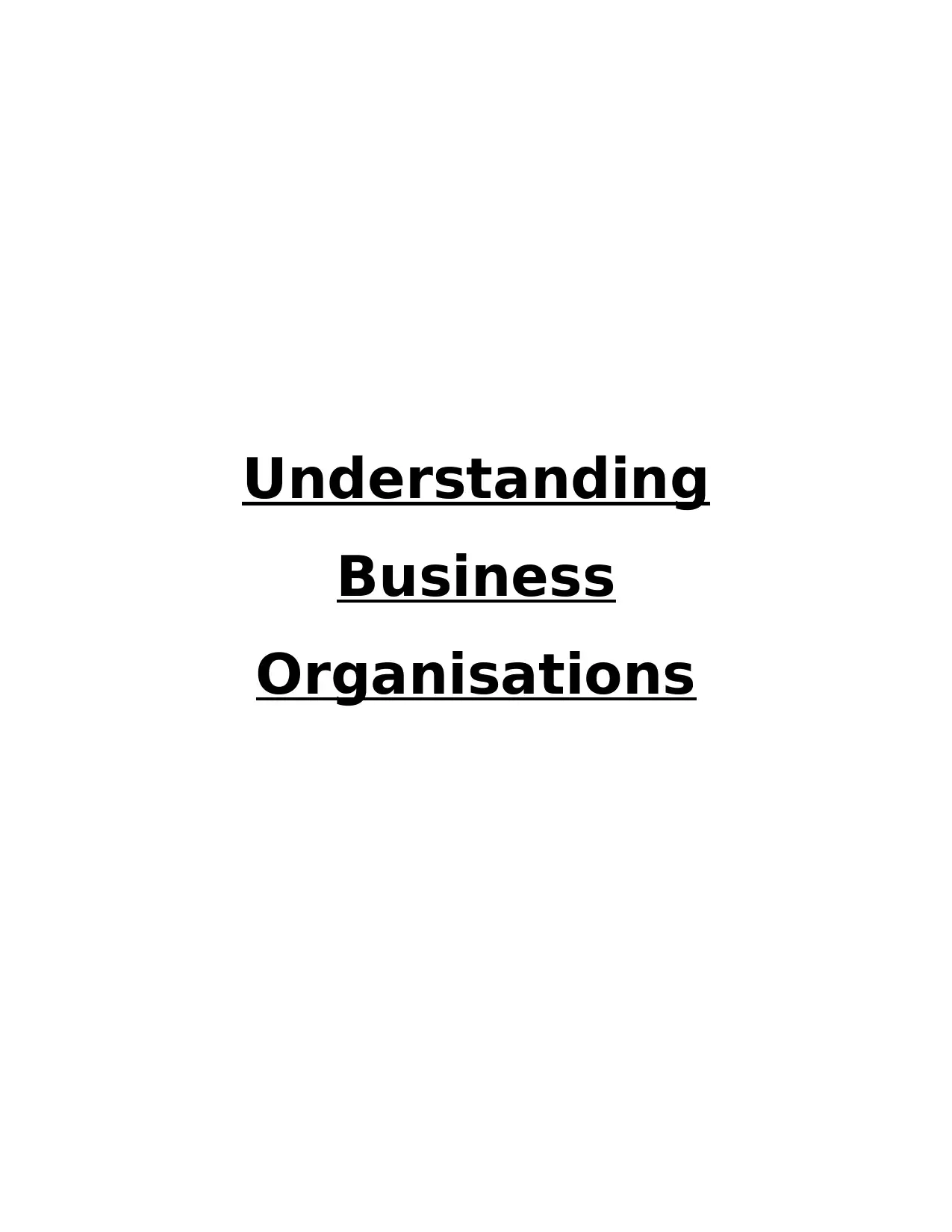
Understanding
Business
Organisations
Business
Organisations
Secure Best Marks with AI Grader
Need help grading? Try our AI Grader for instant feedback on your assignments.
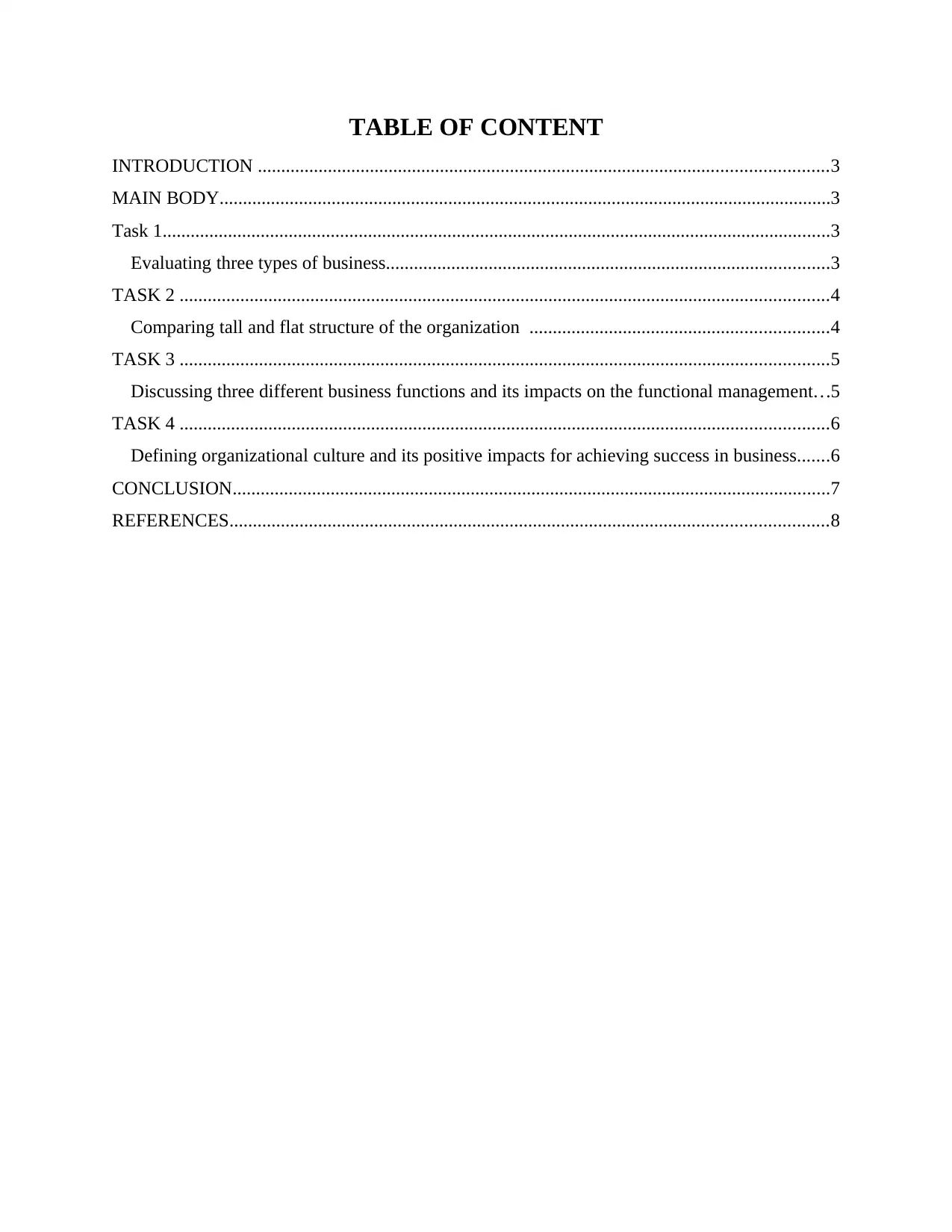
TABLE OF CONTENT
INTRODUCTION ..........................................................................................................................3
MAIN BODY...................................................................................................................................3
Task 1...............................................................................................................................................3
Evaluating three types of business...............................................................................................3
TASK 2 ...........................................................................................................................................4
Comparing tall and flat structure of the organization ................................................................4
TASK 3 ...........................................................................................................................................5
Discussing three different business functions and its impacts on the functional management...5
TASK 4 ...........................................................................................................................................6
Defining organizational culture and its positive impacts for achieving success in business.......6
CONCLUSION................................................................................................................................7
REFERENCES................................................................................................................................8
INTRODUCTION ..........................................................................................................................3
MAIN BODY...................................................................................................................................3
Task 1...............................................................................................................................................3
Evaluating three types of business...............................................................................................3
TASK 2 ...........................................................................................................................................4
Comparing tall and flat structure of the organization ................................................................4
TASK 3 ...........................................................................................................................................5
Discussing three different business functions and its impacts on the functional management...5
TASK 4 ...........................................................................................................................................6
Defining organizational culture and its positive impacts for achieving success in business.......6
CONCLUSION................................................................................................................................7
REFERENCES................................................................................................................................8
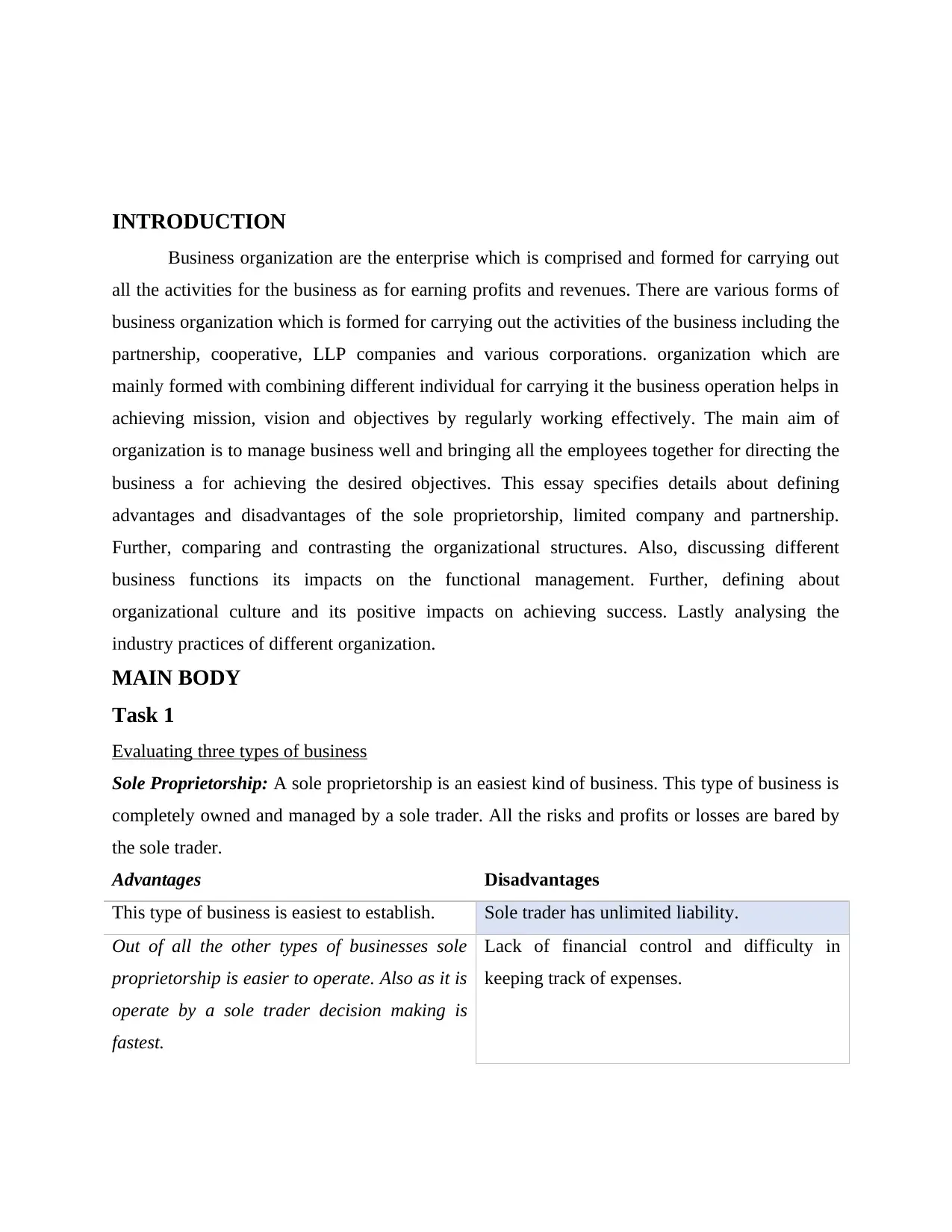
INTRODUCTION
Business organization are the enterprise which is comprised and formed for carrying out
all the activities for the business as for earning profits and revenues. There are various forms of
business organization which is formed for carrying out the activities of the business including the
partnership, cooperative, LLP companies and various corporations. organization which are
mainly formed with combining different individual for carrying it the business operation helps in
achieving mission, vision and objectives by regularly working effectively. The main aim of
organization is to manage business well and bringing all the employees together for directing the
business a for achieving the desired objectives. This essay specifies details about defining
advantages and disadvantages of the sole proprietorship, limited company and partnership.
Further, comparing and contrasting the organizational structures. Also, discussing different
business functions its impacts on the functional management. Further, defining about
organizational culture and its positive impacts on achieving success. Lastly analysing the
industry practices of different organization.
MAIN BODY
Task 1
Evaluating three types of business
Sole Proprietorship: A sole proprietorship is an easiest kind of business. This type of business is
completely owned and managed by a sole trader. All the risks and profits or losses are bared by
the sole trader.
Advantages Disadvantages
This type of business is easiest to establish. Sole trader has unlimited liability.
Out of all the other types of businesses sole
proprietorship is easier to operate. Also as it is
operate by a sole trader decision making is
fastest.
Lack of financial control and difficulty in
keeping track of expenses.
Business organization are the enterprise which is comprised and formed for carrying out
all the activities for the business as for earning profits and revenues. There are various forms of
business organization which is formed for carrying out the activities of the business including the
partnership, cooperative, LLP companies and various corporations. organization which are
mainly formed with combining different individual for carrying it the business operation helps in
achieving mission, vision and objectives by regularly working effectively. The main aim of
organization is to manage business well and bringing all the employees together for directing the
business a for achieving the desired objectives. This essay specifies details about defining
advantages and disadvantages of the sole proprietorship, limited company and partnership.
Further, comparing and contrasting the organizational structures. Also, discussing different
business functions its impacts on the functional management. Further, defining about
organizational culture and its positive impacts on achieving success. Lastly analysing the
industry practices of different organization.
MAIN BODY
Task 1
Evaluating three types of business
Sole Proprietorship: A sole proprietorship is an easiest kind of business. This type of business is
completely owned and managed by a sole trader. All the risks and profits or losses are bared by
the sole trader.
Advantages Disadvantages
This type of business is easiest to establish. Sole trader has unlimited liability.
Out of all the other types of businesses sole
proprietorship is easier to operate. Also as it is
operate by a sole trader decision making is
fastest.
Lack of financial control and difficulty in
keeping track of expenses.
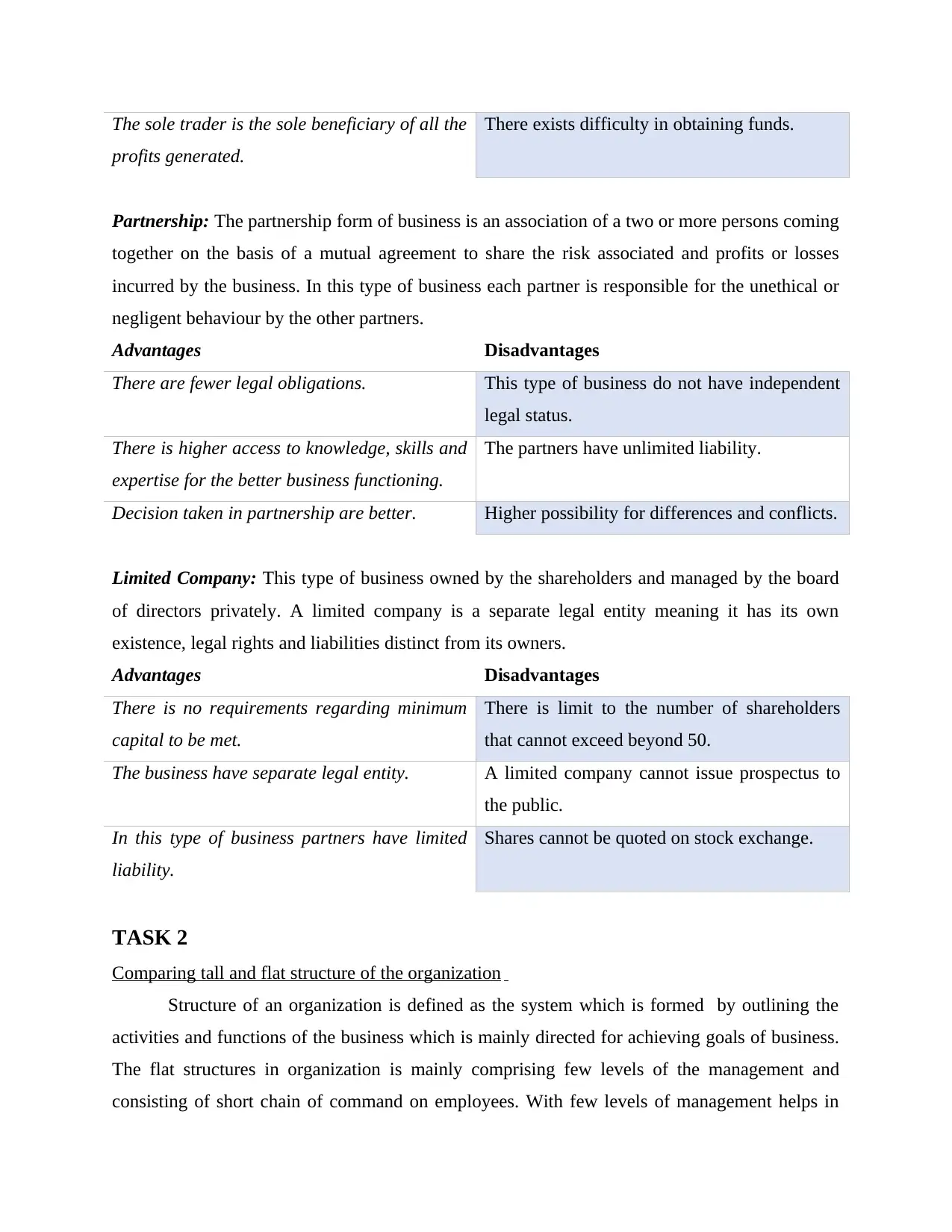
The sole trader is the sole beneficiary of all the
profits generated.
There exists difficulty in obtaining funds.
Partnership: The partnership form of business is an association of a two or more persons coming
together on the basis of a mutual agreement to share the risk associated and profits or losses
incurred by the business. In this type of business each partner is responsible for the unethical or
negligent behaviour by the other partners.
Advantages Disadvantages
There are fewer legal obligations. This type of business do not have independent
legal status.
There is higher access to knowledge, skills and
expertise for the better business functioning.
The partners have unlimited liability.
Decision taken in partnership are better. Higher possibility for differences and conflicts.
Limited Company: This type of business owned by the shareholders and managed by the board
of directors privately. A limited company is a separate legal entity meaning it has its own
existence, legal rights and liabilities distinct from its owners.
Advantages Disadvantages
There is no requirements regarding minimum
capital to be met.
There is limit to the number of shareholders
that cannot exceed beyond 50.
The business have separate legal entity. A limited company cannot issue prospectus to
the public.
In this type of business partners have limited
liability.
Shares cannot be quoted on stock exchange.
TASK 2
Comparing tall and flat structure of the organization
Structure of an organization is defined as the system which is formed by outlining the
activities and functions of the business which is mainly directed for achieving goals of business.
The flat structures in organization is mainly comprising few levels of the management and
consisting of short chain of command on employees. With few levels of management helps in
profits generated.
There exists difficulty in obtaining funds.
Partnership: The partnership form of business is an association of a two or more persons coming
together on the basis of a mutual agreement to share the risk associated and profits or losses
incurred by the business. In this type of business each partner is responsible for the unethical or
negligent behaviour by the other partners.
Advantages Disadvantages
There are fewer legal obligations. This type of business do not have independent
legal status.
There is higher access to knowledge, skills and
expertise for the better business functioning.
The partners have unlimited liability.
Decision taken in partnership are better. Higher possibility for differences and conflicts.
Limited Company: This type of business owned by the shareholders and managed by the board
of directors privately. A limited company is a separate legal entity meaning it has its own
existence, legal rights and liabilities distinct from its owners.
Advantages Disadvantages
There is no requirements regarding minimum
capital to be met.
There is limit to the number of shareholders
that cannot exceed beyond 50.
The business have separate legal entity. A limited company cannot issue prospectus to
the public.
In this type of business partners have limited
liability.
Shares cannot be quoted on stock exchange.
TASK 2
Comparing tall and flat structure of the organization
Structure of an organization is defined as the system which is formed by outlining the
activities and functions of the business which is mainly directed for achieving goals of business.
The flat structures in organization is mainly comprising few levels of the management and
consisting of short chain of command on employees. With few levels of management helps in
Secure Best Marks with AI Grader
Need help grading? Try our AI Grader for instant feedback on your assignments.

improving decision-making processes and organizes the financial status of the business (Fan and
et.al., 2022). Further more this structure help employee in better working and adapting changes
frequently as by responding to all the changes in the dynamic environment by considering the
latest trends and preferences.
Examples of companies following flat structure are Valve and Counter Strike.
In a tall structured organization, the entire structure of the organization is bifurcated into
different hierarchy. Every portion or department of organization is handled and managed by a
departmental head or manager (Joseph and Gaba, 2020). These types of structures are followed
in the organizations that are complex. Hilton Hotel and Resorts and Hyatt Hotel Corporation are
examples of tall organizational structure.
In an organization following flat structure there exists fewer level of management and the
autonomy on the part of employees is higher in the decision making process whereas, in an
organization that follows tall organizational structure the CEO is at the top of the command
chain under which there exists various managerial levels.
In flat organizational structure the less levels ensures the efficient communication within
the organization. Employees are trusted with more autonomy and responsibility making them
feel motivated and providing them with the opportunity to be more productive (Auchter and
et.al., 2018). Whereas on the other hand the tall organizational structure the business areas are
closely managed, the managers have higher control over the actions of the employees and the
progression opportunities excel.
TASK 3
Discussing three different business functions and its impacts on the functional management
Business functions are mainly comprising and conducting activities which
helps in achieving business success by contributing postivley as for effectively working in the
company. as these mainly helps in supporting the business by conducting the roles and
responsibilities of different individuals for achieving the objectives by carrying out day today
business activities.
The three functions of the business are as the operation function, human resources and the
production function.
Operation function: Operation function in the business is mainly responsible for
distributing nd producing various products and services. This mainly helps in forecasting and
et.al., 2022). Further more this structure help employee in better working and adapting changes
frequently as by responding to all the changes in the dynamic environment by considering the
latest trends and preferences.
Examples of companies following flat structure are Valve and Counter Strike.
In a tall structured organization, the entire structure of the organization is bifurcated into
different hierarchy. Every portion or department of organization is handled and managed by a
departmental head or manager (Joseph and Gaba, 2020). These types of structures are followed
in the organizations that are complex. Hilton Hotel and Resorts and Hyatt Hotel Corporation are
examples of tall organizational structure.
In an organization following flat structure there exists fewer level of management and the
autonomy on the part of employees is higher in the decision making process whereas, in an
organization that follows tall organizational structure the CEO is at the top of the command
chain under which there exists various managerial levels.
In flat organizational structure the less levels ensures the efficient communication within
the organization. Employees are trusted with more autonomy and responsibility making them
feel motivated and providing them with the opportunity to be more productive (Auchter and
et.al., 2018). Whereas on the other hand the tall organizational structure the business areas are
closely managed, the managers have higher control over the actions of the employees and the
progression opportunities excel.
TASK 3
Discussing three different business functions and its impacts on the functional management
Business functions are mainly comprising and conducting activities which
helps in achieving business success by contributing postivley as for effectively working in the
company. as these mainly helps in supporting the business by conducting the roles and
responsibilities of different individuals for achieving the objectives by carrying out day today
business activities.
The three functions of the business are as the operation function, human resources and the
production function.
Operation function: Operation function in the business is mainly responsible for
distributing nd producing various products and services. This mainly helps in forecasting and

managing the available resources of the business for creating goods and providing the services
(Al-Kahtani, 2022). In hospitality management this function is mainly responsible for running
day today operations by managing all the activities and supply chain for producing products and
providing services to all the consumers. For example : In Hilton hotel, the front desk manger us
mainly responsible for providing good experiences to all the guest by delivering different
products and services a of cleaning rooms, maintaining housekeeping for providing best and
satisfying services to all the guest arriving at the hotel.
Human resource: This function in the business is mainly recognized for handing and
managing all the employees for effectively working and serving the company with providing
best services for achieving the objectives. In hospitality this function play important role as it
helps in fulfilling needs and maintains operations by working effectively (Jehan and et.al., 2022).
Example: In the Premier inn, the HR mainly aids increasing all the details and maximised
productivity of the workforce by compensating, rewarding and scheduling employees for
providing benefits and retaining potential workers.
Production function: This functions is responsible for producing the products as by
satisfying users. This helps in determining the inputs for achieving optimum level of production
(Macchi, Savino and Roda, 2020). In hotels this function supports in producing the food and
beverage to all the guest with providing satisfying services.
TASK 4
Defining organizational culture and its positive impacts for achieving success in business
Culture of an organisation is comprised of collective values, beliefs, mission, objective
which guides employees for achieving business goals. The culture of the business mainly helps
in supporting employees for working effectively as it motivate workers for working better by
engaging employees for achieving the desired business objectives. Strong and healthy culture
helps in satisfying workers with providing job satisfaction and helps in gaining productivity by
boosting morale. The working culture helps in motivating employees for achieving the business
objectives . As it mainly engages and retain the competent personnels.
Culture impacts positively when the working culture in the company is flexible and
postivley established for achieving the business objectives. It supports employees for learning
better and enhances working practices by effective and efficiently working with utilizing all the
available resources. This assist in raising and improving team wok by better collaborating for
(Al-Kahtani, 2022). In hospitality management this function is mainly responsible for running
day today operations by managing all the activities and supply chain for producing products and
providing services to all the consumers. For example : In Hilton hotel, the front desk manger us
mainly responsible for providing good experiences to all the guest by delivering different
products and services a of cleaning rooms, maintaining housekeeping for providing best and
satisfying services to all the guest arriving at the hotel.
Human resource: This function in the business is mainly recognized for handing and
managing all the employees for effectively working and serving the company with providing
best services for achieving the objectives. In hospitality this function play important role as it
helps in fulfilling needs and maintains operations by working effectively (Jehan and et.al., 2022).
Example: In the Premier inn, the HR mainly aids increasing all the details and maximised
productivity of the workforce by compensating, rewarding and scheduling employees for
providing benefits and retaining potential workers.
Production function: This functions is responsible for producing the products as by
satisfying users. This helps in determining the inputs for achieving optimum level of production
(Macchi, Savino and Roda, 2020). In hotels this function supports in producing the food and
beverage to all the guest with providing satisfying services.
TASK 4
Defining organizational culture and its positive impacts for achieving success in business
Culture of an organisation is comprised of collective values, beliefs, mission, objective
which guides employees for achieving business goals. The culture of the business mainly helps
in supporting employees for working effectively as it motivate workers for working better by
engaging employees for achieving the desired business objectives. Strong and healthy culture
helps in satisfying workers with providing job satisfaction and helps in gaining productivity by
boosting morale. The working culture helps in motivating employees for achieving the business
objectives . As it mainly engages and retain the competent personnels.
Culture impacts positively when the working culture in the company is flexible and
postivley established for achieving the business objectives. It supports employees for learning
better and enhances working practices by effective and efficiently working with utilizing all the
available resources. This assist in raising and improving team wok by better collaborating for
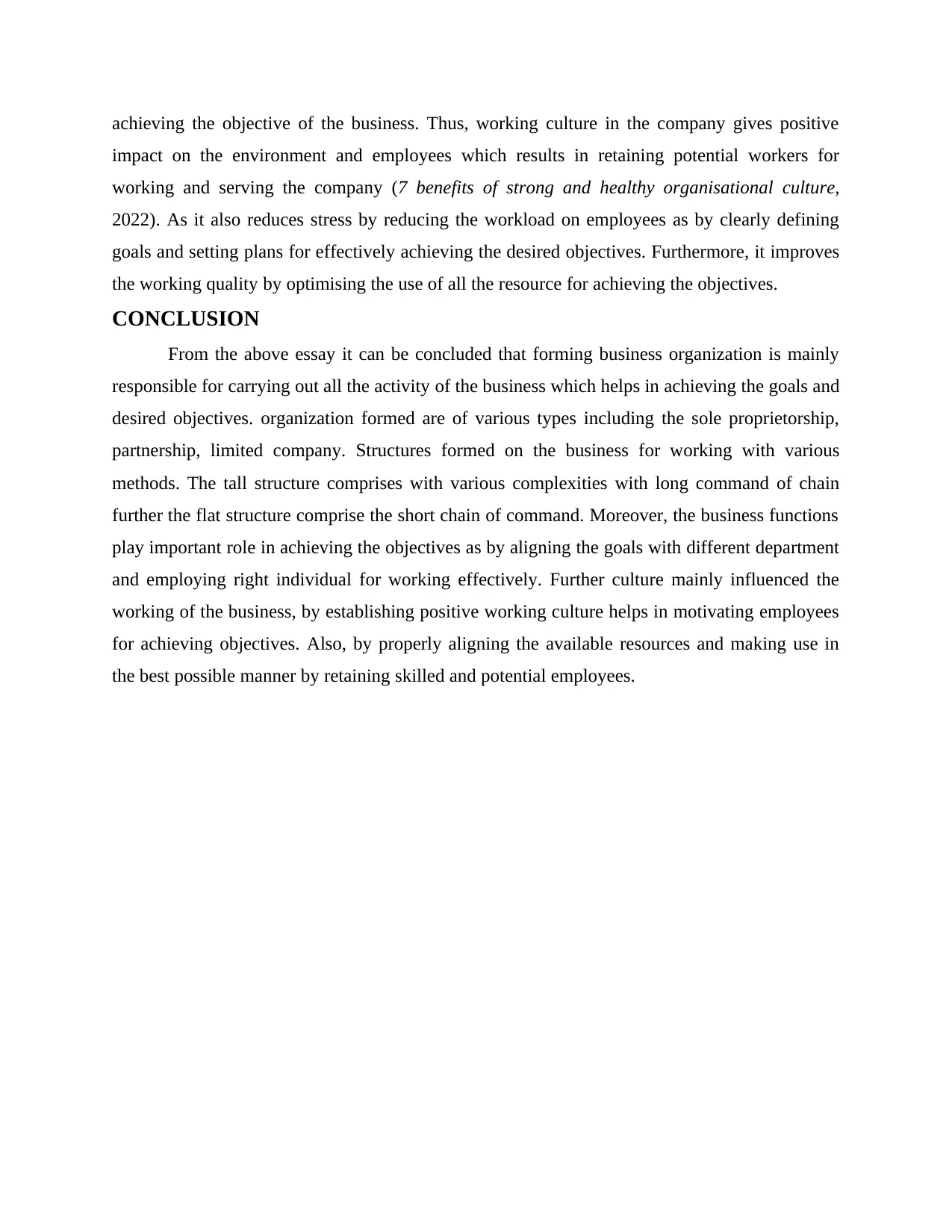
achieving the objective of the business. Thus, working culture in the company gives positive
impact on the environment and employees which results in retaining potential workers for
working and serving the company (7 benefits of strong and healthy organisational culture,
2022). As it also reduces stress by reducing the workload on employees as by clearly defining
goals and setting plans for effectively achieving the desired objectives. Furthermore, it improves
the working quality by optimising the use of all the resource for achieving the objectives.
CONCLUSION
From the above essay it can be concluded that forming business organization is mainly
responsible for carrying out all the activity of the business which helps in achieving the goals and
desired objectives. organization formed are of various types including the sole proprietorship,
partnership, limited company. Structures formed on the business for working with various
methods. The tall structure comprises with various complexities with long command of chain
further the flat structure comprise the short chain of command. Moreover, the business functions
play important role in achieving the objectives as by aligning the goals with different department
and employing right individual for working effectively. Further culture mainly influenced the
working of the business, by establishing positive working culture helps in motivating employees
for achieving objectives. Also, by properly aligning the available resources and making use in
the best possible manner by retaining skilled and potential employees.
impact on the environment and employees which results in retaining potential workers for
working and serving the company (7 benefits of strong and healthy organisational culture,
2022). As it also reduces stress by reducing the workload on employees as by clearly defining
goals and setting plans for effectively achieving the desired objectives. Furthermore, it improves
the working quality by optimising the use of all the resource for achieving the objectives.
CONCLUSION
From the above essay it can be concluded that forming business organization is mainly
responsible for carrying out all the activity of the business which helps in achieving the goals and
desired objectives. organization formed are of various types including the sole proprietorship,
partnership, limited company. Structures formed on the business for working with various
methods. The tall structure comprises with various complexities with long command of chain
further the flat structure comprise the short chain of command. Moreover, the business functions
play important role in achieving the objectives as by aligning the goals with different department
and employing right individual for working effectively. Further culture mainly influenced the
working of the business, by establishing positive working culture helps in motivating employees
for achieving objectives. Also, by properly aligning the available resources and making use in
the best possible manner by retaining skilled and potential employees.
Paraphrase This Document
Need a fresh take? Get an instant paraphrase of this document with our AI Paraphraser
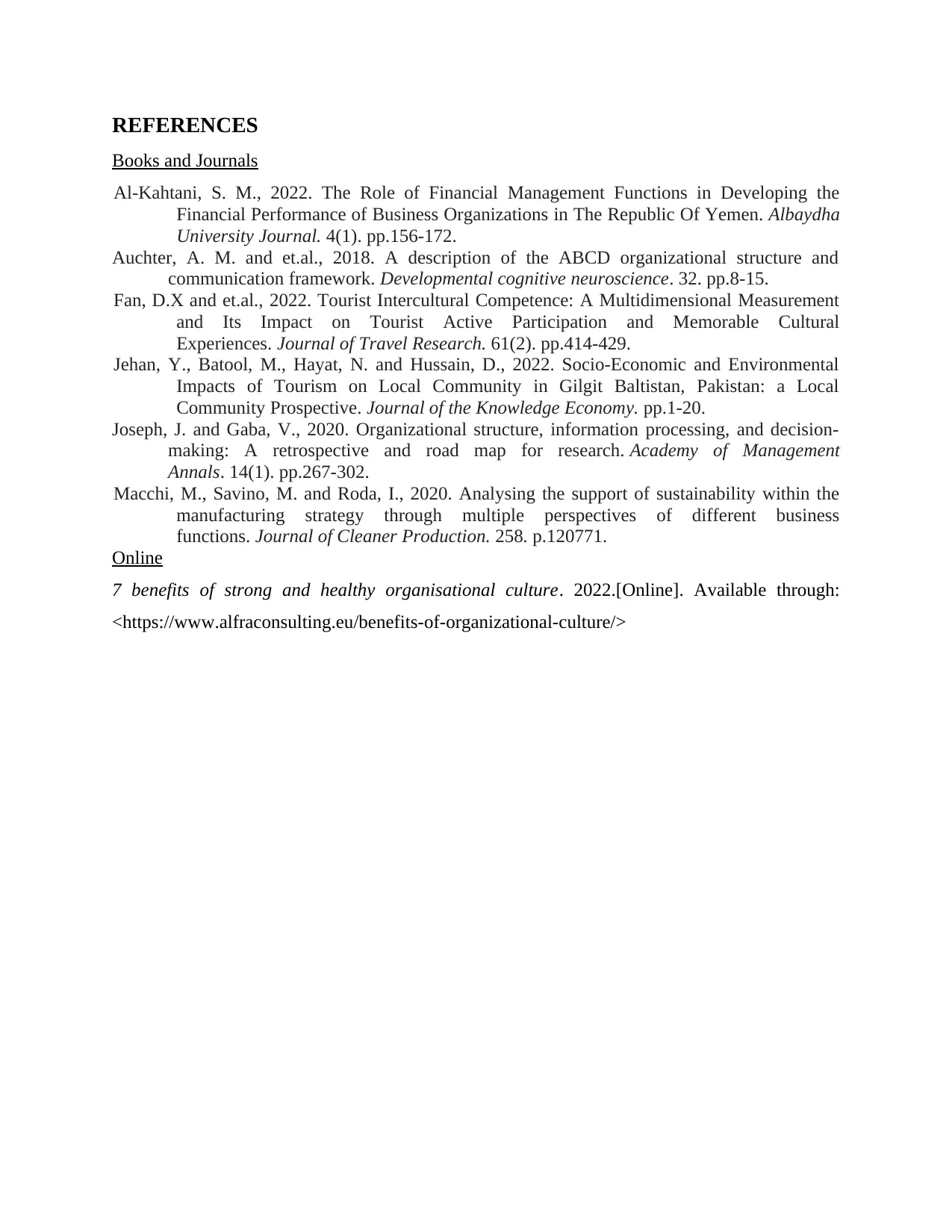
REFERENCES
Books and Journals
Al-Kahtani, S. M., 2022. The Role of Financial Management Functions in Developing the
Financial Performance of Business Organizations in The Republic Of Yemen. Albaydha
University Journal. 4(1). pp.156-172.
Auchter, A. M. and et.al., 2018. A description of the ABCD organizational structure and
communication framework. Developmental cognitive neuroscience. 32. pp.8-15.
Fan, D.X and et.al., 2022. Tourist Intercultural Competence: A Multidimensional Measurement
and Its Impact on Tourist Active Participation and Memorable Cultural
Experiences. Journal of Travel Research. 61(2). pp.414-429.
Jehan, Y., Batool, M., Hayat, N. and Hussain, D., 2022. Socio-Economic and Environmental
Impacts of Tourism on Local Community in Gilgit Baltistan, Pakistan: a Local
Community Prospective. Journal of the Knowledge Economy. pp.1-20.
Joseph, J. and Gaba, V., 2020. Organizational structure, information processing, and decision-
making: A retrospective and road map for research. Academy of Management
Annals. 14(1). pp.267-302.
Macchi, M., Savino, M. and Roda, I., 2020. Analysing the support of sustainability within the
manufacturing strategy through multiple perspectives of different business
functions. Journal of Cleaner Production. 258. p.120771.
Online
7 benefits of strong and healthy organisational culture. 2022.[Online]. Available through:
<https://www.alfraconsulting.eu/benefits-of-organizational-culture/>
Books and Journals
Al-Kahtani, S. M., 2022. The Role of Financial Management Functions in Developing the
Financial Performance of Business Organizations in The Republic Of Yemen. Albaydha
University Journal. 4(1). pp.156-172.
Auchter, A. M. and et.al., 2018. A description of the ABCD organizational structure and
communication framework. Developmental cognitive neuroscience. 32. pp.8-15.
Fan, D.X and et.al., 2022. Tourist Intercultural Competence: A Multidimensional Measurement
and Its Impact on Tourist Active Participation and Memorable Cultural
Experiences. Journal of Travel Research. 61(2). pp.414-429.
Jehan, Y., Batool, M., Hayat, N. and Hussain, D., 2022. Socio-Economic and Environmental
Impacts of Tourism on Local Community in Gilgit Baltistan, Pakistan: a Local
Community Prospective. Journal of the Knowledge Economy. pp.1-20.
Joseph, J. and Gaba, V., 2020. Organizational structure, information processing, and decision-
making: A retrospective and road map for research. Academy of Management
Annals. 14(1). pp.267-302.
Macchi, M., Savino, M. and Roda, I., 2020. Analysing the support of sustainability within the
manufacturing strategy through multiple perspectives of different business
functions. Journal of Cleaner Production. 258. p.120771.
Online
7 benefits of strong and healthy organisational culture. 2022.[Online]. Available through:
<https://www.alfraconsulting.eu/benefits-of-organizational-culture/>
1 out of 8
Related Documents
Your All-in-One AI-Powered Toolkit for Academic Success.
+13062052269
info@desklib.com
Available 24*7 on WhatsApp / Email
![[object Object]](/_next/static/media/star-bottom.7253800d.svg)
Unlock your academic potential
© 2024 | Zucol Services PVT LTD | All rights reserved.



